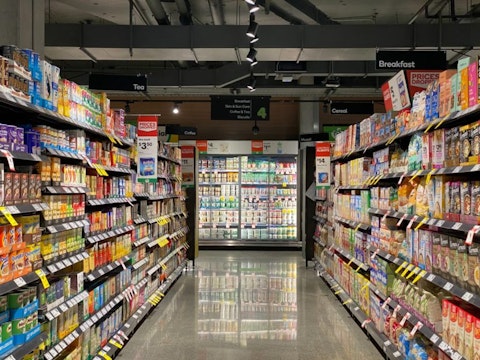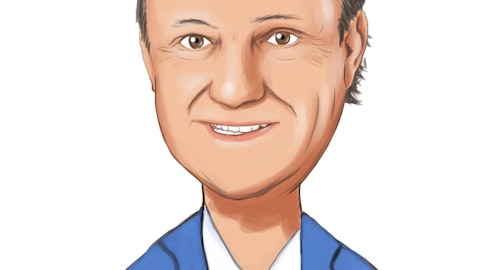Express, Inc. (NYSE:EXPR) Q2 2023 Earnings Call Transcript September 6, 2023
Express, Inc. misses on earnings expectations. Reported EPS is $9.05 EPS, expectations were $11.07.
Operator: Good morning. My name is Jean Louis and I will be your conference operator today. I would like to welcome everyone to the Express Inc. conference call to discuss our second quarter 2023 earnings. All lines have been placed on mute to prevent any background noise. After the speakers’ remarks, there will be a question and answer session. If you would like to ask a question during this time, simply press star followed by the number one on your telephone keypad. If you would like to withdraw your question, again press star, one. I would now like to hand the call over to Greg Johnson, Vice President of Investor Relations. Please go ahead.
Greg Johnson: Thank you Operator. Good morning and welcome to EXPR’s second quarter 2023 earnings conference call. Our second quarter 2023 earnings release and presentation can be found at our Investor Relations website. These items will be archived and our call will be available for replay. I’d like to open by reminding you of the company’s Safe Harbor provisions. Today’s call may contain forward-looking statements. Any statements made during this conference call except those containing historical facts may be deemed to constitute forward-looking statements within the meaning of the Private Securities Litigation Reform Act of 1995. Actual future results may differ materially from those suggested in forward-looking statements due to a number of risks and uncertainties.
For a description of the risks that could cause our results to differ materially from those described in forward-looking statements, please refer to our 2022 Form 10-K and our other filings with the SEC, which are posted on our Investor Relations website. These risks and uncertainties are further detailed in our earnings press release that was issued this morning. These statements represent our current judgment. Express assumes no obligation to update any forward-looking statements whether as a result of new information, future events or otherwise, except as required by law. In addition, we may refer to certain non-GAAP measures. You can locate a reconciliation of any non-GAAP measures discussed in our comments to amounts reported under GAAP in our earnings release and in the corresponding presentation.
We will also be providing financial comparisons to prior fiscal periods, and our prepared remarks today refer to comparisons to the corresponding periods in 2022 unless otherwise noted. Please see the explanatory notes in the earnings release for additional details regarding the definition of certain items. Lastly, I would like to remind everyone about our recent 1-for-20 reverse stock split. As a result of the reverse stock split, shares in our consolidated financial statements have been retroactively adjusted, and shares outstanding went from 74.9 million shares to 3.7 million shares. With the reduction in weighted average shares outstanding, our second quarter 2023 diluted loss per share outlook of $0.50 to $0.60 was recast to $10 to $12.
Our second quarter 2023 diluted loss per share of $11.79 was within this range, while our adjusted diluted loss per share of $9.05 was favorable to this range. This adjusted figure excludes certain restructuring charges, acquisition-related and integration costs, and a non-cash impairment charge, each of which are detailed further in the schedule attached to our earnings release. With me today are Tim Baxter, Chief Executive Officer, and Jason Judd, Chief Financial Officer. I will now turn the call over to Tim.
Tim Baxter: Thanks Greg. Good morning everyone and thank you for joining us. Our second quarter net sales and diluted loss per share were both within the ranges of our outlook. Our adjusted diluted loss per share was favorable to the range, which reflects the ongoing aggressive actions we have implemented to improve our profitability. It’s important to note that the results we reported today are reflective of the reverse stock split that Greg just reviewed, which is symbolic of a new chapter for EXPR. We are committed to creating shareholder value by, first, driving profitable growth and delivering positive free cash flow in our core Express-branded business; second, by leveraging our fully integrated omnichannel platform to reduce costs; and third, by accelerating our growth and profitability through our strategic partnership with WHP Global.
While our results were within the ranges of our outlook, they were not where they need to be in the Express brand and we continue to be intensely focused on taking corrective action to address the most significant challenges we have faced: first, imbalances across the women’s product assortment; second, challenging comps in men’s and outlet as we lap record top and bottom line performances in 2022; and finally, the ongoing dynamic macroeconomic environment and related consumer pressure on discretionary spending in categories like apparel and accessories. The corrective actions we have taken are working and our customer is responding. We delivered significant sequential improvement in our top line performance each month as we flowed new product.
This positive momentum and improvement continued through Labor Day, giving us confidence that we will deliver substantially improved sales performance in the back half of the year, which is reflected in our outlook. Improvement was most powerful in our women’s business, where our new deliveries reflect a more appropriate balance across categories, price points and wearing occasions. Customer response has been so strong that it drove our women’s business to a positive 2% comp in July, a trend that further accelerated to a plus-12% comp in August. We are now chasing into best selling products and categories, which has always been a winning formula for Express. In September, we also re-introduced innovative icons, which have been incredibly well received.
While our women’s results are very encouraging, we still have ground to make up versus our pre-pandemic levels, which will be critical as we work to offset other pressures. Although not as strong an improvement as we have experienced in women’s, our men’s business delivered a positive comp on a two-year basis in the first half of the year. Challenges will persist in Q3 as we continue to lap record performances and work to offset the high average unit retails and margins in suits, our largest business, with increased sales in tops, jeans and casual bottoms all at lower AURs. From a channel perspective, the assortment actions we have taken also drove sequential improvement in ecommerce, retail stores and outlet stores. In fact, women’s product performed so well on ecommerce that women’s delivered a plus-1% comp in June, a plus-17% comp in July, and accelerated to a plus-28% comp in August.
Given our high penetration of women’s online, this momentum was strong enough to deliver total ecommerce sales flat in June, plus-9% in July, and plus-18% in August. This momentum in ecommerce was a key factor in partially offsetting performance in both store channels, where traffic continues to be very challenged. We have put strategies in place to mitigate the traffic challenges by driving increases in conversion, units per transaction, and average dollar sales. Our roll-out of RFID to our retail stores in the second quarter will be a key enabler of these strategies, and we expect to see improvement in our store trends in the back half of the year. Improvement in the top line isn’t good enough, and so we have also taken very aggressive action to drive significant improvement on the bottom line.
As a result of the ongoing comprehensive review of our entire expense structure, we have identified and implemented $80 million in expense savings for 2023 and inclusive of these savings over $120 million in 2024, and we are not done. We are committed to over $200 million in savings by 2025, which includes $50 million in gross margin expansion opportunities by leveraging efficiencies in sourcing, production and the supply chain. A portion of these savings has come in the form of reduced marketing spend, so we’re focusing our spend on higher ROAS tactics to drive higher spend and frequency per customer, and it’s working. Going forward, we also expect to be able to reactivate lapsed customers at higher rates as our momentum continues to build.
As I said earlier, the first and most critical component of our shareholder value creation plan is driving profitable growth and delivering positive free cash flow in our core Express branded business. We remain relentlessly focused on this and are confident that the actions we have taken to date, our ongoing review of our business model, and the sales momentum we are building have put us back on the right track. The second component of our value creation plan is leveraging our omnichannel platform. Many of you likely still think of us as a mono branded, mall-based specialty retailer, which is no longer true. We entered into our strategic partnership with WHP Global in order to acquire and operate a portfolio of omnichannel brands, knowing that this portfolio would create significant synergies now and in the future.
I don’t think we’ve gotten credit for the value that this partnership has already created. Our Express intellectual property was valued at $400 million at the time of the transaction, and we maintain a 40% stake valued at $157 million. EXPR is now a platform company operating a portfolio of omnichannel brands that is comprised today of Express, Bonobos, and UpWest. We have positioned the Express brand to generate positive free cash flow, which can be strategically reinvested in our existing business and future acquisitions, while both the Bonobos and UpWest brands are positioned to be top and bottom line growth engines. As I mentioned earlier, we are aggressively pursuing at least $50 million in gross margin expansion through efficiencies in sourcing, production and the supply chain, but the work doesn’t stop there and we know there is more opportunity as we identify synergies in technology, procurement, and our real estate portfolio.

Photo by Franki Chamaki on Unsplash
We expect that there will be much more to come here as we advance the work we’re doing on all of this. The third component of our value creation plan is accelerating our growth and profitability through our strategic partnership with WHP Global. In the Express brand, this acceleration will come in the form of international and non-core domestic category licensing, both of which are already in motion and to date, the response to the Express brand has been overwhelmingly positive. Each of these license agreements will generate guaranteed minimum royalties beginning in 2024 that will be accretive on day one. Perhaps the most transformative part of this strategic partnership is that it enabled us to pursue acquisitions like Bonobos, which was completed in the second quarter.
Since the acquisition date, Bonobos sales have exceeded our expectations and delivered operating income accretive to our total. We expect it to be accretive to operating income and to deliver positive free cash flow for the full year. Bonobos is a very good example of the highly disciplined financial approach we intend to take with any future acquisition and represents a significant growth opportunity for EXPR. In addition to the substantial cost reductions, we’ve also entered into a definitive agreement for a $65 million asset-based term loan and expect to receive a $52 million CARES Act refund in the back half of the year, which bolsters our liquidity and allows us to continue to invest appropriately in our transformation. Let me turn the call over to Jason to provide further detail on our reverse stock split, future results, the term loan and expected CARES Act refund, and our expectations for improved performance in the back half of the year.
Jason Jud: Thank you Tim, and good morning. I want to reiterate the impact that Greg described at the beginning of this call of the 1-for-20 reverse stock split, as the per-share performance and outlook that I provide will reflect it. On August 30, EXPR implemented a reverse stock split that decreased our shares outstanding of 74.9 million shares to 3.7 million shares. The impact on earnings per share is clear. Our outlook for the quarter, as described in the Q1 earnings call, was a loss per share of $0.50 to $0.60. Adjusted for the lower share count, that outlook was re-cast to a loss per share of $10 to $12. Our second quarter loss per share of $11.79 fell within our stated outlook range. Adjusting for acquisition-related and integration costs, a non-cash impairment charge and certain restructuring costs, we outperformed out outlook with a loss per share of $9.05.
Moving to our Q2 results, we expected consolidated net sales of $400 million to $450 million with approximately $30 million of sales from Bonobos since the acquisition at the end of May. Consolidated net sales actualized at $435 million, with Bonobos driving $41 million in sales. Net sales were above the midpoint of our range, and Bonobos exceeded our expectations. We expected gross margins to decrease approximately 800 basis points, including approximately 300 basis points of royalty expense related to the license agreement with WHP Global and a positive 200 basis point impact from Bonobos. We saw a decrease of 1,000 basis points. Restructuring and impairment charges had an approximate 90 basis point impact on our gross margin. We expected SG&S deleverage of approximately 300 basis points, including a 100 basis point impact from Bonobos.
SG&A deleveraged 280 basis points, slightly better than our expectations. This, however, included 150 basis points of restructuring charges and acquisition-related and integration costs. Adjusting for these items, SG&A would have deleveraged by 130 basis points, far better than our outlook. Moving to the balance sheet, we expected our inventory to increase 10% to 15% versus last year as we re-balanced our assortment, improved choice counts in our core and iconic categories, and added Bonobos’ inventory to our count. Inventory increased by 20%. While Express inventory levels were consistent with our expectations, our Bonobos inventory cost basis was higher. The increase was due to the valuation attributed to inventory as part of our $27 million acquisition of Bonobos.
Our balance sheet at quarter end includes a $52 million CARES Act receivable we have mentioned before and which we expect to receive in the back half of this year. We are working closely with the IRS as this receivable nears. It is clearly an important milestone as we strengthen our liquidity, a topic that I will address in a moment. At quarter close, we had $59 million of cash and cash equivalents on hand. Borrowings against our asset-based lending facility were $221 million, with $48 million still available for borrowing under the revolver based on our borrowing base as of quarter end. Subsequent to the end of the second quarter, we secured a new $65 million first in, last out asset-based term loan. We entered into the term loan agreement yesterday and have received gross proceeds of $32.5 million.
The remaining proceeds of $32.5 million will be funded on or before September 13. This term loan is a short term measure to strengthen our liquidity position. Over the longer term, we are focused on meaningfully reducing costs, gross margin expansion, and delivering on our goal of over $200 million in annualized savings by 2025. This program, the Express way to profitability, as we have named it, has already been highly productive and positively impactful as evident in our SG&A management in Q2 versus our outlook. As Tim mentioned, for 2023 versus 2022, we have already identified and implemented $80 million of annualized expense savings. Inclusive of these reductions, in 2024 we expect to realize at least $120 million of expense reductions.
As a result of the ongoing comprehensive review of our entire expense structure, from organization design to marketing to information technology, in-store behaviors, everything, our net goal for expense reductions is to realize at least $150 million in annualized benefit by 2025 versus 2022. In addition to expense reductions, we are working with our external advisors on achievable paths to margin expansion by completing a similar comprehensive review of our sourcing, production, logistics, pricing, and promotional processes. We are pursuing opportunities to expand margins by at least $50 million. While these are bold goals, we are committed to achieving them and expect they will drive long term shareholder value. Turning to our outlook for 2023, please note that per-share measurements reflect the completed 1-for-20 reverse stock split and lower share count.
Our full year outlook remains unchanged and takes into consideration the continued uncertain consumer and macroeconomic environment balanced against the impact of the $80 million in annualized expense reductions that we have already implemented and the expected performance of Bonobos. Our outlook for Q3 compared to the third quarter of 2022 is as follows: net sales of approximately $460 million to $490 million, including approximately $50 million in Bonobos sales; gross margin rate to decrease approximately 200 basis points in aggregate, which includes approximately 300 basis points in contraction from the royalty impact of the license agreement with WHP Global and an approximately 300 basis point benefit from Bonobos; SG&A expenses as a percent of sales to leverage approximately 275 basis points, reflecting the aforementioned cost reduction initiative, more than offsetting an approximately 150 basis point deleverage impact from Bonobos; diluted loss per share of $5.50 to $7.50, and consolidated inventory to grow by low double digits with the addition of Bonobos.
Our outlook for the full year remains unchanged and is as follows: net sales of approximately $1.9 billion to $2 billion, including approximately $150 million in Bonobos sales, diluted loss per share of $30 to $34, and capital expenditures of approximately $25 million. We have reduced our capital expenditures by $5 million versus our previous outlook of $30 million, and by $30 million versus our initial outlook on the year of $55 million. We believe this decrease is appropriately responsive to our business results and it also reflects the redeployment of capital to fund the Bonobos transaction and to support our cost reduction initiatives. Now let me turn the call back to Tim.
Tim Baxter: Thanks Jason. It’s been a challenging year at Express and our results put us on the defensive, but we are at a turning point and we are now confidently on the offensive. We are a new platform company with a new strategy, and we are now operating a portfolio of omnichannel brands that is comprised today of Express, Bonobos and UpWest. The Express brand is positioned to generate cash to reinvest in our business, while Bonobos and UpWest are positioned to be our growth engines. Top line momentum is building in the Express brand, and we expect significantly improved performance in the back half of the year. We’ve implemented $80 million in annualized expense savings for 2023, $120 million for 2024, and are committed to delivering $200 million in annualized savings by 2025.
In addition to these substantial cost reductions, we’ve also secured a $65 million term loan and expect to receive a $52 million CARES Act refund in the back half of the year, which bolsters our liquidity and allows us to continue to invest appropriately in our transformation. We are intensely focused on creating shareholder value at EXPR and we are committed to doing it by driving long term profitable growth and delivering positive free cash flow in our core Express business, leveraging our omnichannel platform to reduce costs, and accelerating our growth and profitability through our strategic partnership with WHP Global. Thank you, and I’ll now turn the call back over to the Operator and we will take your questions.
See also 10 Best Brewery and Distillery Stocks To Buy Now and 12 Best Performing Dividend ETFs in 2023.
Q&A Session
Follow Express Inc. (NYSE:EXPR)
Follow Express Inc. (NYSE:EXPR)
Operator: Thank you. [Operator instructions] Your first question comes from the line of Dana Telsey of the Telsey Advisory Group. Your line is open.
Dana Telsey: Hi, good morning everyone. I think unpacking the quarter and the go-forward, when we think about the progress, Tim, that you’ve made in the merchandising with the improvement in the women’s business, what are the key categories that have been working, whether it’s dresses, whether it’s bottoms? Is there a difference between online stores and outlets, and what did you see promotional versus full price and how does that move going forward? When you think about the margins and unpacking the gross margin and the SG&A, how is the promotional environment relative to your plan and AURs? What’s been the progress on AUR and is there any benefit to be detailed, whether it’s from freight or raw material costs, and then when you think under the hood, given the balance sheet and liquidity, how should we be thinking about interest for the balance of the year and into next year? Thank you.
Tim Baxter: Great, good morning Dana. Thank you. There’s a lot to unpack there, so I’m going to start with the women’s business and the improvement that we have seen there. It has been very significant improvement, as I mentioned and I detailed. The improvement is actually coming across all categories as we have regained balance in the assortment, so that’s what’s driving the power of it. We’re truly driving positive comps now across every category in women’s. But the key driver are denim, knits and sweaters, which are obviously at the very beginning of the cycle for the back half of the year, but our initial reads on sweaters are incredibly strong. I’ll start with denim. We were imbalanced from a leg shape perspective in denim.
We had abdicated skinny in favor of the newer leg shapes, and so the assortment was not balanced. As we have re-introduced the skinny leg shape and re-introduced one of our best fabrics, which is called FlexX, into the assortment, our denim business has sort of skyrocketed and we intend to continue to drive the denim business, knowing that that is a key component of success in women’s. Obviously we know that over 80% of our customers actually wear denim to work, but today only about 25% of our customers are buying denim from us, so we know there’s an extraordinary opportunity there in denim. The knits business has been fantastic. Again, we had abdicated some of our opening price points and some of our essentials. As we have reintroduced essentials into the mix at opening price points, we have seen an incredible acceleration in our knits business and body contour continues to be a key component of that business, and we believe we’re going to be able to return to growth actually in the body contour complex as well.
Then I mentioned sweaters – you know, we are off to an extraordinary start in sweaters, and as you know, sweater penetration grows as we move forward in the season, so very confident in the sweater strategy that we have in place. All those things are working really well. I’d also say that our momentum has continued in modern tailoring. Our re-launch of the Editor pant, which was actually a year ago, continued to perform very well even when the total women’s business was challenged, and as we have expanded the Editor franchise to include some additional leg shapes and to include jackets and skirts, the response has been absolutely extraordinary, so modern tailoring being driven by the Editor franchise also working extraordinarily well for us.
Then you mentioned dresses. I would say we still have some work to do in dresses. We’re seeing success in dresses, but not as much success as we should be, to be honest, so we still have some balancing to do there. Our non-red line business, so our new product in dresses is performing extraordinarily well, but we’re up against some pretty significant noise in red lines from a year ago across all categories, actually, that’s holding the total comp back a bit as we’re not anniversarying those very, very deep red line promotions. The second piece of your question, I think – I jotted it down, was about promotion and the promotional environment. We are clearly, clearly seeing a strong desire from the customer on promotion and discount. There is definitely–you know, it is a promotional environment, they are looking for a deal, and so we have been offering very strategic deals, basically.




